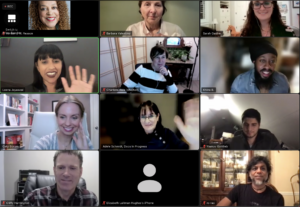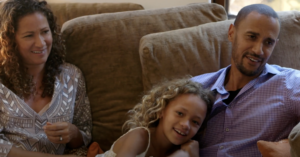
Docs in Progress Silver Screen Series hosted an anniversary film screening and panel discussion on Mixed, a documentary by professors Caty Borum and Leena Jayaswal at American University’s School of Communication. The film, which premiered last October at the Greater Cleveland Film Commission’s Cleveland Premier & Community Conversation, explores biracial identity and the legacy of interracial marriage in the U.S. through intimate conversations between the filmmakers, interracial and biracial families, and researchers. Barbara Valetino, CEO of Docs in Progress, opened the discussion, which was joined by Dr. Sarah Elizabeth Gaither, Assistant Professor of Psychology and Neuroscience at Duke University, and Mixed film editor Charlene Rule. Screenwriter and film editor Khiné B. moderated the conversation.
Inspiration for the Film
 Borum and Jayaswal described how unexpected, sometimes dehumanizing experiences they encounter while parenting their biracial children – questions and comments about their and their children’s skin color differences, for example – motivated them to explore these experiences on film as a way to open up broader conversations about race. In examining this theme, they discovered Dr. Sarah Gaither’s research on biracial and multiracial identities (Gaither, Toosi, Babbitt & Sommers, 2018; Gaither, 2018; Gaither, 2015), which found that biracial and multiracial people fluidly adapt their communication and behavioral styles between, across and within the racial group or groups with which they are engaged. Finding resonance in Gaither’s work, Borum and Jayaswal set out to make a film that would bring into focus the challenges and opportunities biracial people experience, the cultural fluency with which biracial people interact in the world, and how this fluency presents a positive exemplar for building better understanding between people across races.
Borum and Jayaswal described how unexpected, sometimes dehumanizing experiences they encounter while parenting their biracial children – questions and comments about their and their children’s skin color differences, for example – motivated them to explore these experiences on film as a way to open up broader conversations about race. In examining this theme, they discovered Dr. Sarah Gaither’s research on biracial and multiracial identities (Gaither, Toosi, Babbitt & Sommers, 2018; Gaither, 2018; Gaither, 2015), which found that biracial and multiracial people fluidly adapt their communication and behavioral styles between, across and within the racial group or groups with which they are engaged. Finding resonance in Gaither’s work, Borum and Jayaswal set out to make a film that would bring into focus the challenges and opportunities biracial people experience, the cultural fluency with which biracial people interact in the world, and how this fluency presents a positive exemplar for building better understanding between people across races.
Conversation as a Narrative Approach
As the film’s narrators, Borum and Jayaswal initially adopted a traditional, off-screen approach for narrating Mixed. Shortly into filming, however, they and their film editor, Charlene Rule, realized that the stories they shared would only be real if the conversations between them were real – that is to say, took place on screen. “Real conversations are the movie,” Borum noted during the making of the film. For Mixed, this meant choosing a personalized narrative style over an objective, disembodied voice – and this meant being vulnerable as filmmakers.
“The throughline of Mixed is vulnerability,” Borum said later. “Vulnerability is the language of emotion. And that’s where and how social change can happen and continue into the future, even after infrastructure and policy change.”
Jayaswal added that film participants were especially keen on having conversations as a way to explore what it means to be biracial in a culture that expects biracial people to identify with one race and deny the other. “What you’re seeing in the film is us learning along the way by having these personal conversations,” she said. “Conversations we hope Mixed will inspire more people to have as a way to build connection and acceptance.”
Gaither went further by describing the benefits of interracial social interactions in reducing racial barriers. “Exposure – shared and meaningful contact over time – is what breaks down racial biases and changes people’s behavior.” The interactions in Mixed are meaningful, she said, because “they capture the experiences of real people.”
The directors’ choice of a personalized narrative style also lent space for infusing humor into their filmmaking. Since their relationship is jocular by nature, Borum and Jayaswal wanted to allow room for their humor to surface on film. The families featured in Mixed also wanted to have fun, a mutual sensibility among filmmakers and participants that illustrated a key principle behind making the film: That conversations about race can move beyond emotionally-triggered encounters to meaningful, transformative dialogue that is also joyful and light-hearted.
Families in the Film
 For Borum and Jayaswal, including family members in Mixed was an intentional, creative choice, given that the film’s impetus derived from their everyday experiences in raising biracial children. And a film about mixed-race families would not be complete without Richard and Mildred Loving, a married, interracial couple who challenged and overturned U.S. anti-miscegenation laws in the 1967 Supreme Court case, Loving v. Virginia. Featuring the Loving family in Mixed provided essential historical context for entrenched hostility toward and systemic opposition against interracial marriage in the U.S. that began in 1661 with the first anti-miscengation law in Maryland, and persisted decades after the Loving ruling (Alabama did not remove its anti-miscegenation statute until 2000, the last state to do so).
For Borum and Jayaswal, including family members in Mixed was an intentional, creative choice, given that the film’s impetus derived from their everyday experiences in raising biracial children. And a film about mixed-race families would not be complete without Richard and Mildred Loving, a married, interracial couple who challenged and overturned U.S. anti-miscegenation laws in the 1967 Supreme Court case, Loving v. Virginia. Featuring the Loving family in Mixed provided essential historical context for entrenched hostility toward and systemic opposition against interracial marriage in the U.S. that began in 1661 with the first anti-miscengation law in Maryland, and persisted decades after the Loving ruling (Alabama did not remove its anti-miscegenation statute until 2000, the last state to do so).
The experiences of biracial families featured in Mixed provide moving anecdotes to findings from Gaither’s work, which suggest that biracial families and children who embrace all aspects of their biracial identities possess cognitive and social skills that enable them to intuitively navigate complex cultural dynamics across racial groups. “It’s presumed that our (racially-mixed) kids are going to have identity crises,” Jayaswal offered. “But this isn’t how our kids feel at all.” In fact, her family – and Borum’s – were eager to participate in Mixed and were actively engaged in filmmaking. “Usually when I’m making a movie,” Jayaswal said, “my thirteen-year-old son’s response is, ‘Oh, there’s Mom with the camera again.’ In this film, though, we gave our kids ownership by letting them shoot. After filming, my son thanked me for making a film about and with him – an outcome that was a first for us.”
Gaither’s family, on the other hand, was initially nervous about talking about race on film. Their views changed after watching Mixed. Gaither recounted how she had received a call from her brother, who was deeply moved after viewing the film. “He said he had never seen a film that identified so closely with their family’s experiences as mixed people,” Gaither said. “My parents married in 1979, and seeing this film made them feel seen and heard.”
The initial worries that Gaither observed in her family appears to reinforce her research findings, which show that self-esteem, psychological conflict, and cognitive issues arise among biracial children when they are pushed to choose one side of their racial identity over the other (Gaither, 2015; Gaither, Sommers & Ambady, 2013). Gaither’s recent research on the flexibility of biracial and multi-racial people in adapting to racial groups across social and cultural contexts suggests that long-standing pressures for biracial people to identify exclusively with one race and eschew the other – a form of “othering” by the dominant racial group – may well give way to the power of authentic, cathartic conversations on race as biracial and multiracial people, who represent a growing share of the U.S. population, play an increasingly greater role in bridging racial divides.
Resources for biracial and multiracial families:
- Black, White Just Right, Marguerite W. Davol
- Born a Crime, Trevor Noah
- Incognegro and Loving Day, Mat Johnson
- “Losing Your Mixed-Race Kid at the Playground,” W. Kamau Bell
- W. Kamau Bell Has a Mixed Race Baby, CONAN
- Project Race
